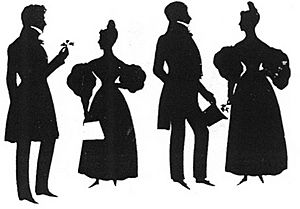Anne Elizabeth Ball facts for kids
Quick facts for kids
Anne Elizabeth Ball
|
|
|---|---|

Left to Right Robert, Anne, Bent and Mary Ball
|
|
| Born | 1808 Cobh, County Cork, Ireland
|
| Died | 1872 (aged 63–64) Dublin, Ireland
|
| Nationality | Irish |
| Scientific career | |
| Fields | Algology, botany |
Anne Elizabeth Ball (1808–1872) was an Irish botanist. She was also an expert in algology, which is the study of algae, like seaweeds. Anne was also a talented botanical illustrator, meaning she drew plants.
She was born in Cobh, Ireland, in 1808. Anne had two siblings who also loved nature: her brother Robert Ball and her sister Mary Ball. Their father, Bob Stawell Ball, was very passionate about natural history. This love for nature inspired all his children.
Early Life and Discoveries
In 1818, Anne Ball and her family moved from Cobh to Youghal. This was another port town in County Cork. Here, when Anne was in her early twenties, she started collecting and studying marine algae. These are plants that grow in the sea.
Later, in 1837, Anne moved to Dublin with her sister and father. She lived there until she passed away. Anne kept collecting algae in Dublin. Even though she was not a member of the official science groups in Dublin, she became a very successful algologist.
Back then, it was common for men to publish the scientific work of women. So, Anne's discoveries were often published by male naturalists. These included William Henry Harvey, who was a friend of her brother, and James Mackay.
However, these relationships were helpful for Anne too. William Harvey supported her work. He even named a group of algae, called Ballia, after her. He also named a specific type of algae, Cladophora balliana, in her honor. Anne found the first sample of Cladophora balliana on May 16, 1843, in Clontarf.
Anne and William Harvey also worked together on his important book, Phycologia Britannica. This book was published between 1846 and 1851. Anne also drew pictures of hydroids, which are tiny sea animals. These drawings were used by William Thompson in his book, The Natural History of Ireland, published in 1856.
Her Lasting Impact
Anne Ball passed away at her home in Dublin in 1872. Her amazing collections of seaweeds are still kept today. They are found in special plant collections called herbaria. You can see them at University College Cork and the Royal (later Irish National) Botanic Gardens, Glasnevin. The Botanic Gardens also have her drawings of seaweeds and fungi.
Some of her collections are at the Ulster Museum. Her letters and plants are also kept at Kew Gardens in England. Many of the plants from Kew Gardens were later moved to the Natural History Museum in London around 1961. This means her important work can still be studied by scientists today.
See also
 In Spanish: Anne Elizabeth Ball para niños
In Spanish: Anne Elizabeth Ball para niños

